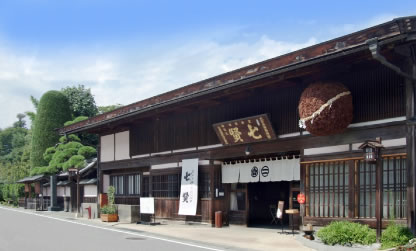
While in Japan one should try the home-country specialty drink - Sake. However, there are almost as many brands and types as American micro-brews. You could head to the store and take your chances, or you can learn just a tiny bit of Kanji to help you make some educated guesses. In a post from many months ago, the Sake (ordering and) Buying Guide, I try to keep it simple. The simplicity is possible because the Japanese are quite an organized society and they've developed standards in the Sake industry.
These standards allow Sake to be divided into groupings based on the degree of rice milling and whether additional alcohol is added or not. They also measure things such as the sweetness/dryness and the acidity. With these items figured out you can make reasonably good Sake choices both in a restaurant and at the store.
A special thanks to Malcolm and Miko for this fine gift shown below. This is a unique sake in several ways.
 |
| Aged Dai Ginjo Sake |
The first thing about this Sake that is unusual is that it's aged. You can see that it has a slight yellow color to it. It is estimated that aged Sake makes up only about .0001% of all Sakes out there. One thing to keep in mind is that Sake is not like wine and is generally meant to be drunk while it is "young." However, an aged Sake done correctly can be very enjoyable. This one is aged for three years.
On this bottle we see 古酒 on the labels.
古 means old and it's a pretty easy Kanji to memorize since it looks like a gravestone.
酒 means Sake or alcohol. In Remembering the Kanji, this is made up of the water radical 氵and "whiskey bottle" (see the whiskey in the bottle with a cap?) 酉 making it pretty easy to come up with a story to get "Sake." Most 7-11s in Japan have a sign outside with that Kanji on it. In that case it simply means alcohol is sold.
地震 means earthquake. I only threw that in there because we just had a good shake.
 |
| Decoding the label |
This particular bottle is from a brewery near Nagano that was established in the year 1750. Think about that for a second. A photo of the brewery is below.
 |
| Sake with a cork |
So there you have it: Aged, DaiGinjo, and a cork. Add them up and you truly have a one-of-a-kind - exceptionally unique Sake. I'll let you know how it tastes in a few.
 |
| The Yamanashi Brewing Company - from http://www.sake-shichiken.co.jp/company.html |
That large ball you see is a "sagidama." They are made of cedar leaves and are replaced when the brew is completed. In the old days sanitation was not that great and often entire batches of Sake would go bad. Cedar has anti-microbial properties so was put out to help ward off problems with the Sake brewing. The sagidama will usually lead you to Sake or a Sake brewery.
* Aficionado Intelligence Reporting (AIR) was conceived of grey bearded men, through brilliant thought, in a small Izakaya on the backstreets of Yokosuka. AIR reports on little known but exceptional (or maybe just really good) dining spots or interesting food developments and relies on highly untrained observers making random observations and developing conclusions through sometimes single data point regression statistical analysis.
Any conclusions from its reporting are final.
No comments:
Post a Comment
Thanks for commenting. All comments are moderated so it may take a day for your comment to be posted. I appreciate the feedback.